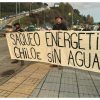Sunday, May 5, 2024
News and Views from the Global South
DEVELOPMENT-NIGER: Fight Against Poverty Gets Mixed Reviews
Ousseini Issa
- The year 1980 proved to be a turning point for Niger, marked as it was by a slump in the sale of uranium, the country’s main export commodity. Since then, Niger has experienced a series of economic crises aggravated by drought – causing poverty in rural and urban areas to deepen.
“The majority of families who live in this district, for example, continue to live in a precarious economic situation, without any assistance,” Hassoumi Saley, a resident of Koira Tegui – a small town near the capital, Niamey – told IPS.
Adds Daouda Ali, a community leader, “We have no modern infrastructure in this neighborhood…We only have one health centre and one borehole, which doesn’t meet our water needs.”
According to Amadou Ibrahim, an economist at the World Bank’s office in Niamey, Niger’s leaders have recognised the need to make the country’s economy less dependent on uranium. However, this recognition was never translated into action.
“Leaders were not just banking on uranium. In their speeches, agriculture and livestock were presented as the lifeblood of Niger’s economy. Unfortunately, there has never been clear economic policy on these two sectors,” Ibrahim said in an interview with IPS.
“No one has ever tried to develop specific industries around cotton or peanuts, for example, or develop a dynamic private sector,” he added. “The consequence has been that with the decline of the uranium market, the country’s export receipts have gone down considerably.”
According to the United Nations Development Programme, 63 percent of Niger’s citizens live below the poverty line of a dollar a day. Food insecurity and a lack of proper housing pose acute problems.
In response to this situation, government – in association with donors – adopted a poverty reduction strategy in January 2002. The programme aims to encourage sustainable economic growth through developing agriculture and other sectors, and to ensure that basic social services are provided to the population. It also promotes good governance.
In addition, the strategy includes a special, presidential initiative for building 1,000 new classrooms, 1,000 clinics and several dams and water points. The initiative also deals with job creation.
“This special program began in 2001 and is financed by the Heavily Indebted Poor Countries Initiative (HIPC). Its aim is to improve rural production, increase health services, school enrollment – and the availability of potable water for both humans and livestock,” Malla Ari, coordinator of the poverty reduction strategy, told IPS.
HIPC was developed by the World Bank to allow poor countries to reduce their external debt, so as to implement poverty reduction programmes. The first phase of the presidential initiative cost about 34.6 million dollars.
“Through this programme, the rate of primary school enrollment went from 37 percent in 2000 to 41.5 percent in 2002…(It) was instrumental in creating several hundred permanent and temporary jobs, thus reducing unemployment,” says Ari. The new jobs were largely in the education, agriculture and fishing sectors.
“The district of Ouallam greatly benefited from the special programme. In the area of education, for example, the rate of school enrollment in 2000 was about 22 percent. Today, it’s 59 percent,” adds Djibo Attinine, assistant chief of police in the south-western district, which is considered one of the poorest in the country.
“As far as health care goes, the rate was about 25 percent. Now it’s 50 percent,” he told IPS.
However, government’s poverty reduction efforts have not elicited glowing praise from all quarters.
“The target communities for these projects are not always involved in the way they’re carried out, which means that water access points were constructed in places where a school was more necessary – or a clinic,” says Adamou Abdou, project coordinator for Socioeconomic Activity Support for Rural Women, a non-governmental organisation (NGO) based in Niamey.
These words are echoed by a resident of Ouallam: “What’s the use of a clinic building or a school building when you have no way to make it function? That’s the sad reality here, where much of the infrastructure built as part of this programme has never been put into operation.”
Even government officials agree that certain projects lacked the appropriate level of forethought and planning.
“Local people were not involved in the way the programme operated, which created this situation…Certain infrastructure was built without trying to find out if it really corresponded to the needs of the beneficiaries,” says Bagoudou Mossi, director of administrative and financial affairs at the Ministry of Planning.
“To get abandoned works – like classrooms and clinics, for example – into service, the government is presently trying to provide them with operating expenses and personnel,” he adds.
These difficulties have led Mamane Sani Adamou – a representative of the NGO, Alternative Citizen Space – to describe government’s poverty relief efforts as little more than a public relations exercise.
“Niger’s HIPC funds, for example, are only 42 billion CFA francs (almost 81 million dollars) officially, over three years,” Adamou told IPS. But, “The scope of poverty in Niger is such that you’d need several tens of billions of francs per year to be able, by 2015, to reduce this scourge by half.”
The international community has set 2015 as the deadline for reaching eight Milliennium Development Goals. These goals were agreed on by member states of the UN in 2000, in a bid to improve education and health in developing nations, amongst other things – and to reduce poverty.
For their part, donors and aid agencies appear satisfied with Niger’s fight against poverty. In May this year, the Paris Club of creditor nations annulled all debts owed by Niger (a sum of 104 million dollars) in order to support the country’s efforts.
According to the World Bank’s Ibrahim, “This debt reduction corresponds to about 5.42 percent of all Niger’s debt, which at the end of December 2003 amounted to 995.4 billion CFA francs (about 1.9 billion dollars).”

 Print
Print



